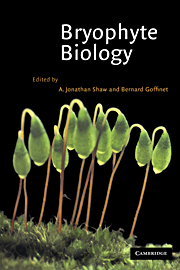Book contents
- Frontmatter
- Contents
- List of contributors
- Preface
- 1 Anatomy, development, and classification of hornworts
- 2 Morphology and classification of the Marchantiophyta
- 3 Morphology and classification of mosses
- 4 Origin and phylogenetic relationships of bryophytes
- 5 Chemical constituents and biochemistry
- 6 Molecular genetic studies of moss species
- 7 Control of morphogenesis in bryophytes
- 8 Physiological ecology
- 9 Mineral nutrition, substratum ecology, and pollution
- 10 Peatlands: ecosystems dominated by bryophytes
- 11 Role of bryophyte-dominated ecosystems in the global carbon budget
- 12 Population ecology, population genetics, and microevolution
- 13 Bryogeography and conservation of bryophytes
- Index
1 - Anatomy, development, and classification of hornworts
Published online by Cambridge University Press: 05 June 2012
- Frontmatter
- Contents
- List of contributors
- Preface
- 1 Anatomy, development, and classification of hornworts
- 2 Morphology and classification of the Marchantiophyta
- 3 Morphology and classification of mosses
- 4 Origin and phylogenetic relationships of bryophytes
- 5 Chemical constituents and biochemistry
- 6 Molecular genetic studies of moss species
- 7 Control of morphogenesis in bryophytes
- 8 Physiological ecology
- 9 Mineral nutrition, substratum ecology, and pollution
- 10 Peatlands: ecosystems dominated by bryophytes
- 11 Role of bryophyte-dominated ecosystems in the global carbon budget
- 12 Population ecology, population genetics, and microevolution
- 13 Bryogeography and conservation of bryophytes
- Index
Summary
Introduction
Recently implicated as the oldest extant lineage of land plants, the anthocerotes hold many clues to the early diversification of terrestrial organisms (Malek et al. 1996, Garbary & Renzaglia 1998, Hedderson et al. 1998, Vaughn & Renzaglia 1998, Beckert et al. 1999, Nishiyama & Kato 1999, Renzaglia et al. 2000). Insights into adaptive strategies that enabled plants to survive during early land radiation and to persist through the millennia are gained through exploration of the morphology and reproductive biology of this ancient plant lineage (Renzaglia et al. in press). Such information also provides an essential foundation for future comparative studies among bryophytes and with basal groups of tracheophytes. In this chapter, we overview the current state of our knowledge on the morphology, ultrastructure, and developmental diversity within the anthocerotes. This information is evaluated from a comparative point of view in a broader context of relationships among streptophyte lineages. Throughout our discussion, we identify future lines of investigation that will provide significant new phylogenetic information on hornworts. Finally, we briefly review the prevalent ideas on the classification of anthocerotes.
Anatomy and development
The description that follows is intended to provide 1) an overview of the unifying morphological features of anthocerotes, 2) a brief survey of diversity in structure among hornwort taxa, and 3) a synthesis of published and unpublished data derived from recent ultrastructural studies.
- Type
- Chapter
- Information
- Bryophyte Biology , pp. 1 - 20Publisher: Cambridge University PressPrint publication year: 2000
- 12
- Cited by



